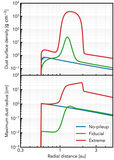Probing the Inner Edge of Dead Zones in Protoplanetary Disks with ALMA and Next Generation Very Large Array
Abstract
The discovery of substructures in protoplanetary disks by the Atacama Large Millimeter/submillimeter Array (ALMA) has provided us with key insights into the formation of planets. However, observational constraints on the formation of rocky planets have been still sparse, especially because of the limited spatial resolution. The inner edge of the so-called dead zone is one of the preferential sites of rocky planet formation. We investigate the capabilities of ALMA and Next Generation Very Large Array (ngVLA) for observing a dust concentration expected at the inner edge of the dead zone around a Herbig star. Herbig Ae/Be stars are useful laboratories for exploring the evolution of rocky grains in protoplanetary disks because of their high luminosity that pushes the dead zone inner edge outward. We find that, thanks to its unprecedented angular resolution and sensitivity, ngVLA can detect the dust concentration at the dead zone inner edge, with a reasonable integration time of 10 hr at λ = 3, 7 mm, and 1 cm. The dust concentration is expected to be optically thick at the ALMA wavelengths and cannot be spatially resolved due to its limited resolution. On the other hand, the flux density from the inner disk regions (~3-4 au) observed with current VLA is higher for disks with a dust ring, and hence would be a useful indicator that helps us choose potential candidates of disks having a dust concentration at the innermost region. With these observations we can characterize the process of dust concentration in the innermost disk regions, where rocky planets can form.
- Publication:
-
The Astrophysical Journal
- Pub Date:
- April 2022
- DOI:
- 10.3847/1538-4357/ac56d8
- arXiv:
- arXiv:2202.09047
- Bibcode:
- 2022ApJ...928..110U
- Keywords:
-
- Protoplanetary disks;
- Planet formation;
- 1300;
- 1241;
- Astrophysics - Earth and Planetary Astrophysics
- E-Print:
- 9 pages, 7 figures, accepted for publication in ApJ
